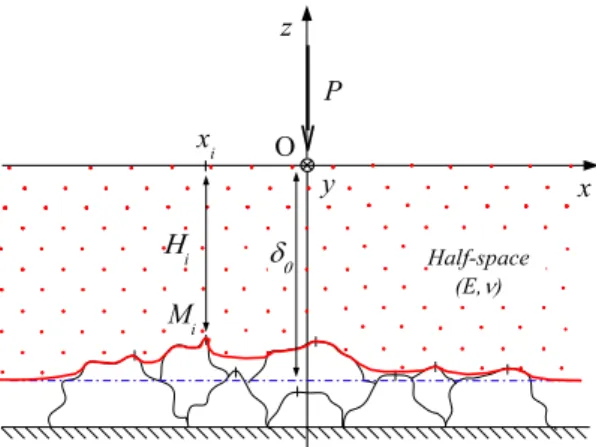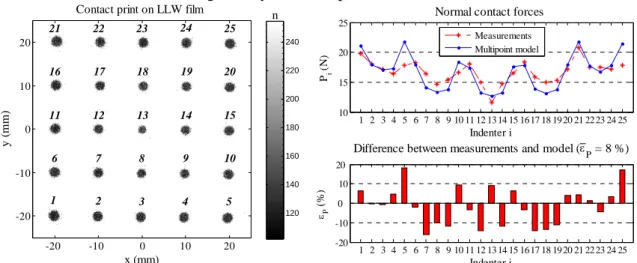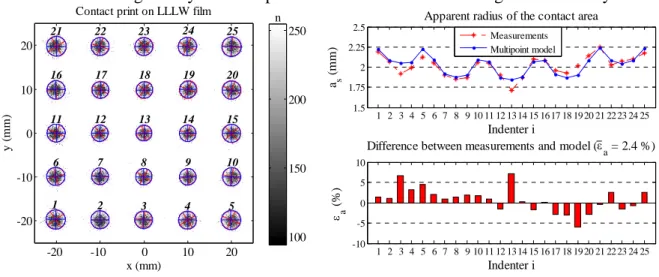HAL Id: hal-01008670
https://hal.archives-ouvertes.fr/hal-01008670
Submitted on 2 Jul 2018HAL is a multi-disciplinary open access archive for the deposit and dissemination of sci-entific research documents, whether they are pub-lished or not. The documents may come from teaching and research institutions in France or
L’archive ouverte pluridisciplinaire HAL, est destinée au dépôt et à la diffusion de documents scientifiques de niveau recherche, publiés ou non, émanant des établissements d’enseignement et de recherche français ou étrangers, des laboratoires
Prediction of contact stresses for tyre-road noise
modelling
Julien Cesbron, Fabienne Anfosso-Lédée, Denis Duhamel, Honoré P. Yin,
Donatien Le Houedec
To cite this version:
Julien Cesbron, Fabienne Anfosso-Lédée, Denis Duhamel, Honoré P. Yin, Donatien Le Houedec. Pre-diction of contact stresses for tyre-road noise modelling. Euronoise 2006, 2006, Tampere, Finland. �hal-01008670�
PREDICTION OF CONTACT STRESSES
FOR TYRE/ROAD NOISE MODELLING
Julien Cesbron1, Fabienne Anfosso-Lédée1, Denis Duhamel2, Honoré Yin2, and Donatien Le Houédec3
1
Laboratoire Central des Ponts et Chaussées
Route de Bouaye, BP 4129, 44341 Bouguenais Cedex, France julien.cesbron@lcpc.fr
2
École Nationale des Ponts et Chaussées
3
École Centrale de Nantes
ABSTRACT
Tyre/road noise is greatly influenced by the dynamic forces generated in the contact patch. The current research for predicting the contact stresses is based on analytical formulations in two or three dimensions.
The paper deals with the validation of an analytical multipoint contact pattern currently developed for introduction in a full model for tyre/road noise. The tyre tread is modelled by an elastic half-space and the road surface by several rigid asperities with random shapes. The contact law for each indenter depends on the interpenetrated volume, the area and the perimeter of its base. The model is three-dimensional and considers the interaction between the contact points.
The contact between a rubber block and a periodic surface composed of spherical indenters was studied. The contact areas and stresses were measured using pressure sensitive Fuji Prescale films. The accuracy of the measurement method was estimated using the hertzian contact between a spherical indenter and the rubber block. The experimental results were compared with the multipoint model.
Next work will focus on the validation of the model for real road surfaces, by evaluating the contact stresses first in statics and then in rolling conditions.
1 INTRODUCTION
Tyre/road noise is greatly influenced by the dynamic forces generated in the contact patch. These forces are due to a complex interaction between the tyre tread and the surface roughness. Sandberg and Descornet [1] showed that tyre/road noise level was linked to road texture level using statistical correlations. Then, an envelopment procedure, based on an analytical contact model in two dimensions, was developed by Klein et al. [2] in order to predict the tyre deformations from road texture profile. An analytical contact model in three dimensions for tyre/road interaction in rolling conditions was developed by Wullens and Kropp [3].
Recently, Sameur [4] proposed an analytical multipoint approach for modelling tyre/road interaction in three dimensions. The purpose of the present study is to validate this model from contact area and pressure measurements for a simple configuration. More realistic cases will be studied in a near future.
2 ANALYTICAL MULTIPOINT CONTACT MODEL
2.1 Hypothesis
The tyre tread is modelled by a perfectly flat three dimensional elastic half-space with a Young’s modulus E and a Poisson’s ratio ν. The road surface is described by several perfectly rigid indenters with random shapes. The surfaces in contact are frictionless, which means that there is no tangential tractions and only the normal pressure is taken into account in the contact area.
The contact problem is solved in statics along the driving path line for each space step Δx.
The time-dependence of the contact forces is then obtained by a combination of the static results at each time step Δt = Δx/V, where V is the car velocity during rolling.
2.2 Contact model for a single asperity with random shape
The contact between an elastic half-space and a single asperity with random shape can be described by the theory of interaction potential of Wilke [4]. When a normal load P is applied on the elastic half-space, its surface penetrates into the indenter. The normal deformation of the surface δ at the summit of the indenter is called the interpenetration.
The relation between P and δ is named the contact law. It can be calculated from the interaction potential U using equation (1), where c is a constant depending on the indenter shape and Ω, Σ and Γ are respectively the interpenetrated volume, the area and the perimeter of its base. δ δ δ ∂ ∂ = ( ) ) ( U P where ) ( ) ( ) ( 1 15 8 ) ( 4 7 2 1 2 2 4 3 δ δ δ ν π δ Σ Γ Ω − =c E U (1)
The model was analytically and experimentally validated for single spherical and conical asperities by Sameur [4]. The constant c was 0.36 for a sphere and 0.45 for a cone, which means that the geometry of the indenter has a small influence on the contact force.
2.3 Multipoint formulation
When the elastic half-space is loaded on a surface composed of N asperities (Fig.1), the total normal load P is divided into N normal forces Pi applied at the summit Mi of each
indenter.
These forces are figured out using the interaction potential Ui as in equation (1). The local
interpenetration δi at the point Mi is calculated from the total interpenetration δ0, the height Hi
and the interaction displacement ui due to the forces existing at the other points Mj.
Fig. 1. Contact between the elastic half-space and several asperities with random shapes.
The multipoint formulation results in a system of N non-linear equations (2) with N unknowns Pi. The interaction coefficients Tij are calculated from the Boussinesq’s theory [5]
for a concentrated normal force loading the surface of an elastic half-space.
∑
= = − − ∂ ∂ = ∈ ∀ N j j ij i i i i i H u with u T P U P N i 1 0 ) ( ], , 1 [ δ δ (2)The problem is solved using the Newton-Raphson’s iterative method. Then, the contact areas and the pressure distribution are locally calculated from the normal forces Pi.
3 EXPERIMENTAL VALIDATION FOR A SIMPLE CONTACT PROBLEM
The quasi-static contact between a rubber block and a periodic surface composed of 25 spherical indenters was studied. The purpose was to validate the multipoint model from contact force and area measurements for a simple configuration.
3.1 Experimental set-up
The rubber block was a square parallelepiped of side 140 mm and thickness 20 mm. The Young’s modulus E of the rubber was estimated from a pure compression test (E = 5.25 MPa) and its Poisson’s ratio assumed to be ν = 0.5.
The periodic surface was elaborated using 25 steel-made rolling balls of equal radius (R = 5 mm). The spherical indenters were arranged as shown in Fig. 2 and their summits were in the same plane.
The surfaces of the bodies were brought into contact using a press (Fig. 2) and the total applied load P was measured during the experiment.
Fig. 2. Periodic surface and experimental set-up for the contact tests with the rubber block.
3.2 Measurement of contact forces and areas
The contact forces and areas were measured using LLW and LLLW Fuji Prescale films at the contact interface. Such films are color-forming materials which print density depends on the pressure level. Each film has its own applicable pressure range (0.5 to 2.5 MPa for LLW film and 0.2 to 0.6 MPa for LLLW film). Thus, the LLW film, which has a wide pressure range, is well suited for contact force measurements, while the LLLW film is more adapted for area measurements, since it is very sensitive but saturates very fast.
The precision of the films was estimated using the Hertz’s contact theory [6] between a single spherical indenter and the rubber block. It was found that the differences between experiments and theory were less than 6 %, considering an equivalent Young’s modulus
Eeq = 6.54 MPa for the composite structure composed of the film and the rubber block.
The contact forces were measured using LLW Fuji film. An example is given in Fig. 3 for a total normal force P = 419 N. The mean gray level inside the print of each indenter was calculated. It was converted in a mean contact pressure using a calibration curve. The LLW film was calibrated following the recommendations of Liggins et al. [7]. Then the contact forces Pi were calculated by multiplying the mean pressure by the apparent contact area,
which was evaluated using the number of reacted pixels. The measured forces were compared to the theoretical normal forces given by the multipoint model.
x (mm)
y (
m
m
)
Contact print on LLW film
25 24 23 22 21 16 17 18 19 20 15 14 13 12 11 6 7 8 9 10 5 4 3 2 1 -20 -10 0 10 20 -20 -10 0 10 20 120 140 160 180 200 220 240 n 1 2 3 4 5 6 7 8 9 10 11 12 13 14 15 16 17 18 19 20 21 22 23 24 25 10 15 20 25
Normal contact forces
Indenter i Pi (N ) Measurements Multipoint model 1 2 3 4 5 6 7 8 9 10 11 12 13 14 15 16 17 18 19 20 21 22 23 24 25 -20 0 20 -10 10
Difference between measurements and model (ε
P = 8 %)
Indenter i
ε (%P
)
The contact areas between the rubber block and the periodic surface were measured using LLLW film. An example is given in Fig. 4 for a total normal force P = 500 N. For each spherical indenter, the apparent contact radius as was locally estimated from the contact print
in gray level n, using a best-fit ellipse procedure [8]. The measured radii were compared to the theoretical radii given by the multipoint model and calculated using Hertz’s theory.
x (mm)
y
(
mm)
Contact print on LLLW film
25 24 23 22 21 16 17 18 19 20 15 14 13 12 11 6 7 8 9 10 5 4 3 2 1 -20 -10 0 10 20 -20 -10 0 10 20 100 150 200 250 n 1 2 3 4 5 6 7 8 9 10 11 12 13 14 15 16 17 18 19 20 21 22 23 24 25 1.5 2 2.5 2.25 1.75
Apparent radius of the contact area
Indenter i a s ( mm) 1 2 3 4 5 6 7 8 9 10 11 12 13 14 15 16 17 18 19 20 21 22 23 24 25 -10 0 10 -5 5
Difference between measurements and model (εa = 2.4 %)
Indenter i ε a (% ) Measurements Multipoint model
Fig. 4. Comparison between the experimental and the theoretical apparent radii for P = 500 N.
3.3 Results
The contact forces and the radii of the contact areas were measured using Fuji films and compared to the multipoint model for four loads P varying between 289 N and 500 N. The average errorsε andP ε for forces and contact radii and their standard deviations a Δ and εP
a
ε
Δ were calculated for each loading case. The results are given in Table 1.
The differences between experiments and theory were less than 10 % for the contact radii, which is fairly acceptable. However, the differences can be over 10 % for the contact forces. This could be explained by the difficult calibration of the LLW films that leads to some uncertainties. This problem has to be investigated more thoroughly for a reliable validation of the model.
Table 1. Errors between experiments and model for the contact forces and the apparent radii.
P (N) εP(%) ΔεP(%) εa(%) Δεa(%) 289 5.6 ± 5.8 5.1 ± 3.9 355 7.3 ± 5.1 4.4 ± 3.3 419 8.0 ± 5.4 3.5 ± 3.0 500 8.8 ± 6.8 2.4 ± 1.9 4 CONCLUSIONS
The analytical multipoint contact model was formulated for the contact between an elastic half-space and a surface composed of asperities with random shapes. It was experimentally
validated for contact areas for a periodic surface of spherical indenters. However, the differences between experiments and theory for contact forces were not fully satisfactory.
Further investigation is needed for the validation of the multipoint model. For instance, a more accurate experimental procedure or device (Tekscan) could be used or the model could be compared to a FEM model. Finally, next work will focus on the validation for more complex configurations, in statics first and then in rolling conditions.
REFERENCES
[1] U. Sandberg and G. Descornet. Road surface influence on tire/road noise. In
Proceedings of the 9th International Conference on Noise Control Engineering (Internoise 1980), pages 1-16, Miami, Florida, 8-10 December 1980.
[2] P. Klein, J-F Hamet, and F. Anfosso-Lédée. An envelopment procedure for tire/road contact. In Surf 2004 – Symposium AIPCR sur les caractéristiques de surfaces de
chaussée, Toronto, June 2004.
[3] F. Wullens and W. Kropp. A three-dimensional contact model for tyre/road interaction in rolling conditions. Acta Acustica united with Acustica, 90:702-711, 2004.
[4] A. Sameur, Modèle de contact pneumatique/chaussée pour la prévision du bruit de
roulement. PhD Thesis, École Nationale des Ponts et Chaussées, 2004.
[5] J. Boussinesq, Application des potentiels à l’étude de l’équilibre et du mouvement des
solides élastiques. Paris, Gauthier-Villars, 1885.
[6] H. Hertz, Über die Berührung fester elastischer Körper (On the contact of elastic
solids). J. Reine und Angewandte Mathematik, 92:156-171, 1882.
[7] A. B. Liggins, J. C. E. Stranart, J. B. Finlay, and C. H. Rorabeck, Calibration and
Manipulation of Data from Fuji Pressure-Sensitive Film. Experimental Mechanics –
Technology Transfer between High Tech Engineering and Biomechanics, Ed. E. G. Little, p. 61-70, Elsevier Science Publishers B. V., 1992.
[8] J. Haddadnia, M. Ahmadi and K. Faez, An efficient feature extraction method with pseudo-Zernike moment in RBF neural network-based human face recognition system.


